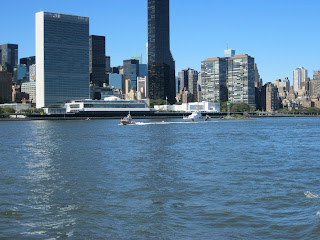The alarm clock went off at 5:20 a.m.
Even though darkness greeted us, it was up and at'em for us. Dogs
walked and fed, coffee perking, at 5:45 we left the dock of the Great
Kills Yacht Club in Staten Island, out into New York Harbor
and then the Atlantic, cruising just a mile offshore of New Jersey.
Finally, light began to appear and we watched a glorious sunrise.
The ocean was quite nice actually. Again, the captain called it right! West winds at 10-15 mph, 3-1/2
footers with 11 second duration (we normally like to see 2 seconds
per foot). But it was chilly, so we opted for driving in the
pilothouse.
The forecast for Tuesday was less
favorable, plus the Baltimore TrawlerFest was looming and we were
running out of time to get there, so John and I discussed the option
of continuing on to Baltimore that night. I do like sleep, don't get
me wrong; but I'm happy to forgo some in lieu of a more comfortable
ride. The Delaware Bay is not only an open body of water, but it's
shallow depths can make it extremely choppy. So we decided to stop
in Cape May for fuel and dog walk, and keep going. After a long day,
the girls were happy to be on land! Plus they always enjoy barking
at – and trying to chase - the cats that live at Utsch's Marina.
When we started down the Cape May Canal towards Delaware Bay it was
dusk. The Delaware brought total darkness. Unfortunately the tide
was against us, with 2-3 knots against us, seriously slowing us up
and making the trip longer than necessary. John took the first
watch. I awoke just after we entered the C&D canal, and he
turned over the helm to me. Thanks to good ol' Wikipedia, here is
some history about the canal:
In 1919 the canal was purchased by the federal government for $2.5 million and designated the "Intra-coastal Waterway Delaware River to Chesapeake Bay, Delaware and Maryland". Included were six bridges plus a railroad span owned by the Pennsylvania Railroad. They were replaced during the 1920s by four vertical lift spans and a new railroad bridge.
Responsibility for operating, maintaining and improving the waterway was assigned to the U.S. Army Corps of Engineers, Wilmington District. By 1927 the eastern entrance at Delaware City had been relocated several miles south at Reedy Point, Delaware. All locks (except the one at Delaware City) were removed and the waterway was converted to a sea-level operation at 12 feet (3.7 m) deep and 90 feet (27 m) wide. These improvements cost $10 million. Two stone jetties at the new eastern entrance were completed in 1926.
The "new" canal opened in May 1927 with great celebration, yet plans already were underway for further expansion as the sizes of ships and amounts of cargo continued to increase. The Philadelphia District took over operation of the canal in 1933. Between 1935 and 1938 the channel was again improved — deepened to 27 feet (8.2 m) and widened to 250 feet (76 m) at a cost of nearly $13 million
Cargo ships of all sizes, tankers,
container-carrying vessels, barges accompanied by tugboats, and
countless recreational boats create a steady flow of traffic.
Now it was John's
turn to rest. Despite our state-of-the-art radar, I sat upright in
the chair my entire watch, completely focused on what was going on.
We have seen many barges and container ships go down this canal and I
did not want to encounter one. About half way - with 7 miles to go -
fog set in. Oh great! Fortunately it wasn't so heavy that I
couldn't see the dimly lighted banks of the canal. I gave thanks for
electronic navigation and stayed focused on that as my guide. Then,
as the canal widened into Chesapeake Bay, the lighted markers
increased, and navigating became a little more challenging. I
decided it was time to wake John for some assistance, although I
hated to do it. He got us through that area, went back to sleep, and
I took the helm again. The Bay was choppy but not too bad. The wind
was from the south at 15 mph which made for a bit of a sloppy ride.
We arrived in Baltimore Harbor shortly after sunrise, then dropped
the anchor, lowered the dinghy, took the dogs ashore, and hit the
hay. It had been a long 27 hours. We were tired.




















